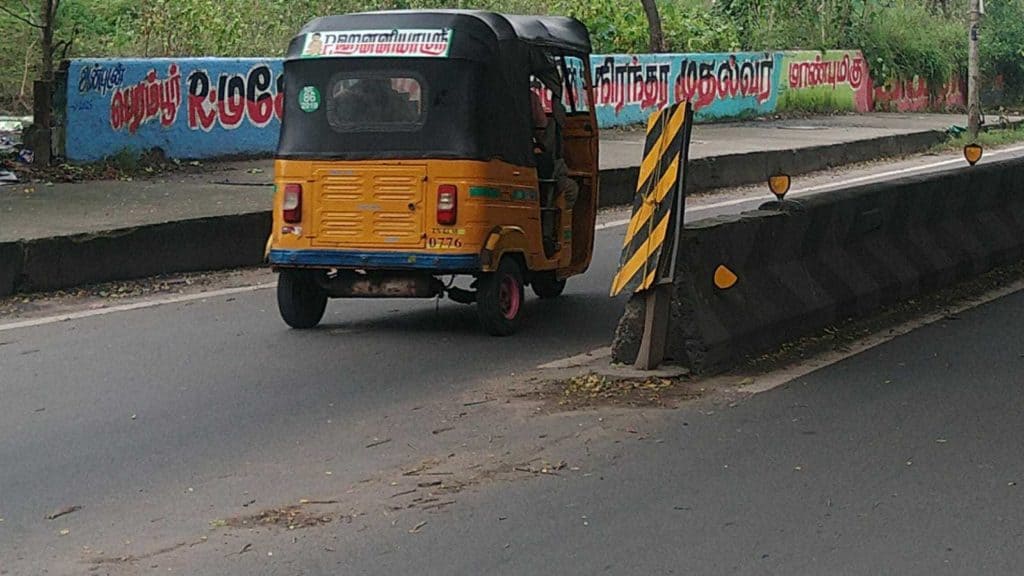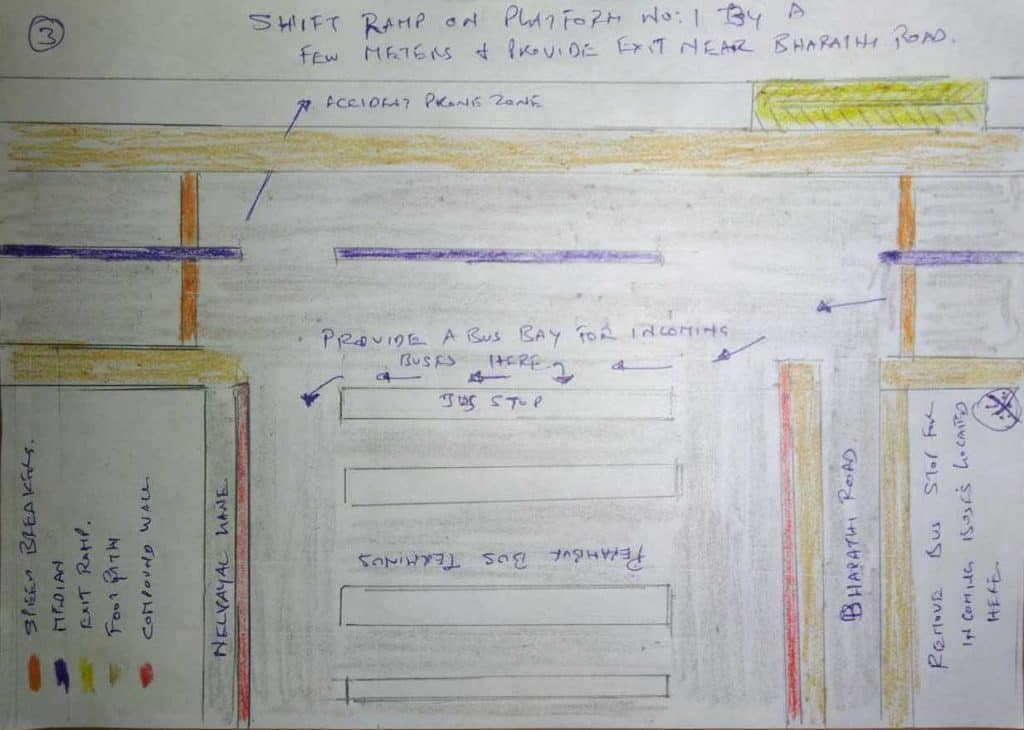Civic or community engagement is a continuous process, which requires relentless efforts. Members from Community Welfare Brigade W70Z6 and Perambur Neighborhood Development Forum have been actively engaging with the local administration and enforcement agencies on issues of public interest. While we have managed to address several issues, others are yet to be resolved. For example, what would a workable, efficient traffic plan for Perambur High Road entail?
Community issues are complex and it’s important to make the problem-solving process inclusive so that decision-makers have a better understanding of their community’s needs and aspirations before setting a course of action.
A traffic plan for Perambur High Road
Perambur High Road, unlike other arterial Bus Route Roads, is near a Railway Station and sees heavy traffic. It is a narrow road with bottlenecks near the railway station. With the railway tracks on one side, the only option available for widening the road would be redevelopment on the opposite side, which is a mix of commercial as well as residential buildings.
Even as residents grapple with traffic woes, the much-awaited second phase of the Chennai Metro Rail work has finally commenced in the area. The construction of the station and the underground tunnels is expected to begin soon.
With these changes set to take place in the coming months, it is important to address the bottlenecks near the Perambur Railway Station before the traffic situation worsens. The traffic woes in this stretch of Perambur is completely man made.
A viable plan to combat issues with traffic and lack of space for pedestrians would include the following:
- Dedicated Parking Lots for Two Wheelers and Cars
- Dedicated Parking Bay for Auto Rickshaws on one side of the Road along the Railway Tracks between the Perambur Bus Terminus & Saraswathi Square
- Footpaths on either side of the road which are free from any encroachment
- Well marked Zebra Crossings or Skywalk to help pedestrians cross the road
- A proper concrete road divider/median with speed breakers at all important intersections
Moving exit ramps
The exit ramp provided at the East End of the railway station on to Perambur High Road North Side deserves to be relocated. The present location of the exit is causing a lot of inconvenience for the commuters and also the residents in the neighborhood.
We would suggest the exit be provided near the Perambur Bus Terminus, as it would help facilitate a smooth transfer of passengers from one mode of transport to another. The road near the bus terminus is wider and the entire stretch of the footpath along the railway track can be converted into a parking bay for the auto rickshaws.
With the arrival of the metro line, the area will have access to the Railways, MTC and the CMRL in this location along with autos and share autos for their last mile connectivity. If our suggestion is implemented, the integration of the multi-modal transport system can be made seamless, encouraging more people to use public transport.
Completion of median
The stalled construction of the road divider on Perambur High Road North Side is another major cause of concern. The decision was taken abruptly and the contractors left behind an incomplete concrete structure in the middle of the road which does not serve any purpose. We seek the completion of the stalled median. If this cannot be done immediately, officials must consider installing speed breakers at the important intersections to curb overtaking and over speeding.
We would urge that an opening be provided at the Perambur High Road – Saraswathi Square intersection immediately because many commuters are seen taking a shortcut from Saraswathi Square to reach Perambur High Road by driving on the wrong side of traffic.
Read more: What stalled median work in Perambur tells us about local governance
Decongesting bus stops
There are too many bus stops close to the Perambur Railway Station – some of the outgoing buses stop opposite to the Railway Station before taking the flyover and others stop on Madhavaram High Road before taking the same bridge. Share autos as well as regular autos are seen occupying the bus bay, causing obstruction and chaos near the Railway Station main gate.
We would suggest that the Bus Bay provided opposite to the Railway Station be removed and the bus stops merged so as to have one stop on Madhavaram High Road. This will ease the traffic congestion opposite to the Railway Station to a great extent.
The bus stop located opposite to the Hyderabad Briyani outlet near the Bharati Road – Perambur High Road intersection near the Perambur Bus Terminus is another bottle neck. Whenever a bus stops here the rest of the vehicles are forced to stop and wait until the bus moves.
The Perambur Bus Terminus was renovated and redeveloped using approximately Rs 75 lakh from the MLA’s funds early this year. The old building which housed the Booking Office, Time Keepers Office and rest rooms for the crew members is in dilapidated condition and likely to be demolished.
We would suggest that this space be provided to build a bus bay for incoming buses before they enter the Terminus to pick up passengers for the next trip. A bus bay similar to what has been provided at the MGR Central Station could be a good idea. The bus stop located on the opposite side of the road near the bus terminus can also be removed and the buses passing through Perambur Bus Terminus can take a detour to enter the bus terminus, pick up the passengers and continue the journey.
If these suggestions are implemented, the congestion on the road can be eliminated to allow continuous free flow of traffic.
Read more: Will CUMTA finally get going with a push from the World Bank partnership?
Tackling encroachments
None of the restaurants or commercial establishments on Perambur High Road have provided sufficient parking space for their customers. This in turn encourages illegal parking on the footpaths as well as the road right opposite to their outlets causing obstruction and inconvenience to the pedestrians.
New buildings which were constructed only in the recent past after procuring necessary permissions have subsequently converted their parking spaces and rented it out. Commercial establishments get away doing what they want only because the officials consider them to be the cash cows in our system.
Footpath and road encroachment has made things very difficult for the common man on the street. Sign boards, hoardings, fast food & chat counters, roadside kitchens, extended awnings are some of the obstacles we need to cross or endure if we decide to take a walk along Perambur High Road.
Why civic engagement matters
The key reason for the community coming forth with these suggestions is their faith in civic engagement. Civic engagement is a public process and it keeps decision-makers accountable. In a well informed society people deserve to have transparency over the decision-making process and they should feel their input was taken into account. It also gives individuals in the community an opportunity to understand how a perspective or need, which was different from their own, had to be catered to. It gives them better understanding and acceptance of the final decision or outcome.
Knowing that all ideas and inputs have been fairly addressed and incorporated can drastically improve public sentiment around an initiative that we are driving. By engaging all stakeholders of public policy projects – local governments and organizations, businesses, residents and communities – we can deepen democracy and ensure that people have a say over the decisions that impact their everyday lives. Engagement with the local residents can help to identify roadblocks, which might otherwise blow out the timeframes and costs of a project that governments are running.
By taking into account the community’s needs and priorities, the local administration can ensure the project runs smoothly and the budget is used effectively. Complaints and protests that might otherwise hold up the initiatives can be identified, addressed, and catered to in the initial stage of the process when the strategy, resources, and budget are established.
Residents in the neighbourhood have a deep and intimate knowledge of their area, as well as historical, and cultural insights. When these perspectives are shared between all parties and incorporated into decision-making, public decision-makers are better informed, more confident and able to meet all needs. By establishing communicative relationships between the local officials and the community, governments can also improve the quality of their services and people will feel they have played their part in the positive outcomes.
The local administration should seek out marginalized or overlooked voices and create avenues for people of all backgrounds, motivations and persuasions to speak up. The overall objective is to yield a balanced understanding of the community’s views and enhance the value of the final decision.

